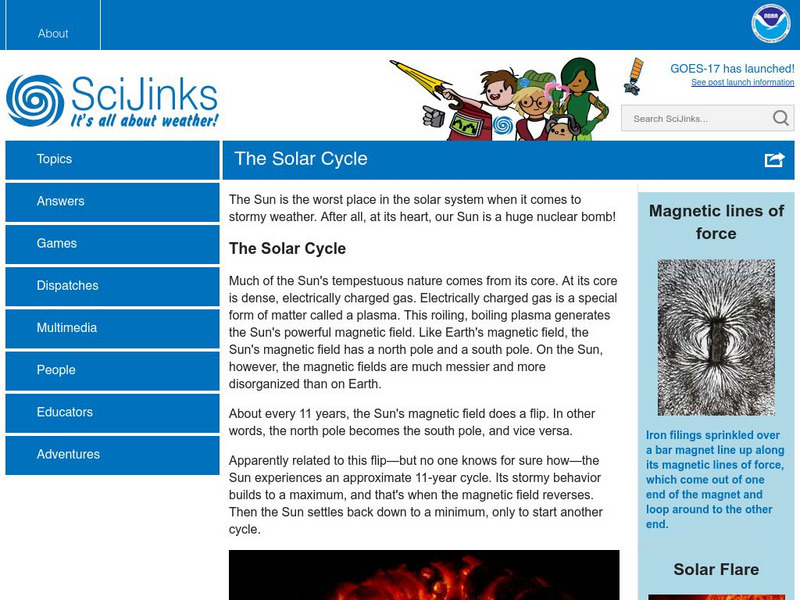Hi, what do you want to do?
PBS
Pbs Learning Media: Sun, Moon, and Star Patterns in the Sky: Lesson Plan
Observe how the Sun, Moon, and stars are visible in the sky at different times of the day and identify predictable patterns in the apparent motion of these objects with this WGBH lesson plan. Students record and analyze data to identify...
Better Lesson
Better Lesson: Equal Groups: How Many Stars in the Sky?
Third graders develop their understanding of multiplication by grouping objects into equal groups to model the factors and products.
Nine Planets
The Nine Planets: The Moon
Explore the mythology, structure, observational history, gravitational force, and orbit of Earth's Moon.
Other
Center for Educational Resources: Sky Paths
Lesson activities where students observe and describe the movements of objects in the sky in both daytime and nighttime. They learn how early cultures regarded the skies, and the stories they told about them. Students will be given the...
NASA
Sci Jinks: Why Does the Sun Have Temper Tantrums?
The sun is a huge volatile object in the sky. Find out what makes it so unpredictable.
NASA
Nasa: Astronomy Picture of the Day: Crab Nebula and Geminga in Gamma Rays
Explains that pulsars would be the brightest objects in the sky if we could see gamma-rays.
Better Lesson
Better Lesson: Our Sky
What objects are in the day sky and the night sky? How do they seem to move? Come and explore with us as we discover the sun, moon, planets and stars! This detailed lesson plan includes pictures and videos of the instructional activity...
Other
Sea and Sky: Celestial Objects
Empty space in outer space is not truly empty. Celestial objects fill the space not occupied by planets, stars, and such. This resource identifies these objects and further explains their existence.
BSCS Science Learning
Bscs: Global Night Sky Comparison
This inquiry invites students to investigate human impacts on the environment. Specifically, students will examine the relationship between human population, light pollution, and how brightly celestial objects like stars appear in the...
NASA
Nasa: Astronomy Picture of the Day: Gamma Ray Quasar
A photograph and description of quasar 3C279 viewed in gamma-rays. It was unexpectedly discovered and was one of the brightest objects in the gamma-ray sky until it suddenly faded.
NASA
Astronomical Society of the Pacific: Telescope Treasure Hunt
This hands-on astronomy activity lets learners hunt for different objects in the night sky that contribute to stellar and planetary formation, using a Treasure List. They will learn how stars and their planets form and will find objects...
TeachEngineering
Teach Engineering: State Your Position
To navigate, you must know roughly where you stand relative to your designation, so you can head in the right direction. In locations where landmarks are not available to help navigate (in deserts, on seas), objects in the sky are the...
TED Talks
Ted: Ted Ed: What Are Those Floaty Things in Your Eye?
Sometimes, against a uniform, bright background such as a clear sky or a blank computer screen, you might see things floating across your field of vision. What are these moving objects, and how are you seeing them? This video explains...
University of Virginia
University of Virginia: How the Greeks Used Geometry to Understand the Stars
An article explaining how the Greeks were able to use their science and mathematics to predict where astronomical objects such as the Planets could be found in the nighttime sky even though their underlying premise was that the earth did...
Khan Academy
Khan Academy: Angular Measure 1
Do you know the size of the sun? Using angular measurement can help astronomers measure objects in the sky.
PBS
Star Map
This star map has five different constellations along with four newly discovered solar systems. If you are located in the northern hemisphere you can use this resource to locate stars.
TeachEngineering
Teach Engineering: Navigating at the Speed of Satellites
For thousands of years, navigators have looked to the sky for direction. Today, celestial navigation has simply switched from using natural objects to human-created satellites. A constellation of satellites, called the Global Positioning...
Science Education Resource Center at Carleton College
Serc: How High Is Big? Using an Astrolabe
Learners observe and measure the shadows of fixed objects throughout the school year to learn about how the seasonal change affects the sun's position in the sky.
Other
Sky Server: Scavenger Hunt
In this site, from the SkyServer of the Sloan Digital Sky Survey users hunt for stars, galaxies, quasars, asteroids and meteors. Learn what they look like and how to find them.
Globio
Glossopedia: Stars
Many of the objects you can see in the night sky are stars, large objects in space that produce light. Our galaxy, the Milky Way, contains more than 100 billion stars. Stars are so far away that their light does not reach us for years....
Curated OER
Science Kids: Science Images: Telescope
This photo shows a common telescope used to observe the stars and other astronomy related objects seen in the night sky such as planets, moons and comets.
Enchanted Learning
Enchanted Learning: English (Esl) Label Me! Printouts
Over 100 handouts with answer sheets you can print and use to help build English vocabulary. Numerous topics and themes are covered: everyday words, math terms, seasonal and holiday words, geographical terms, animals, opposites, parts of...






















